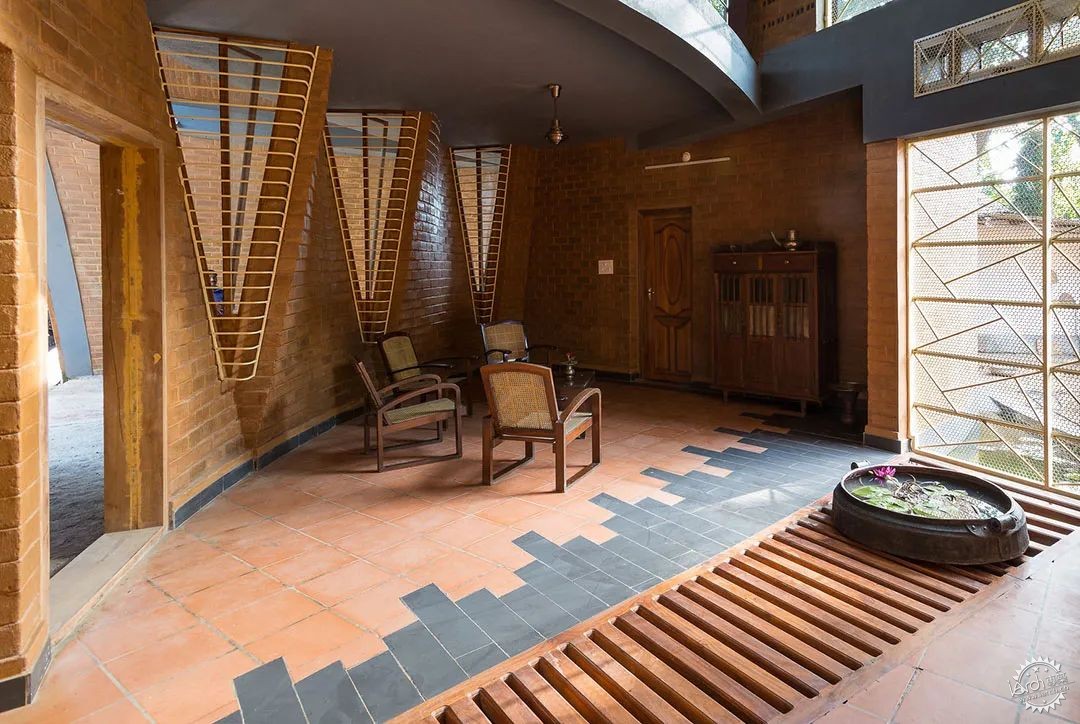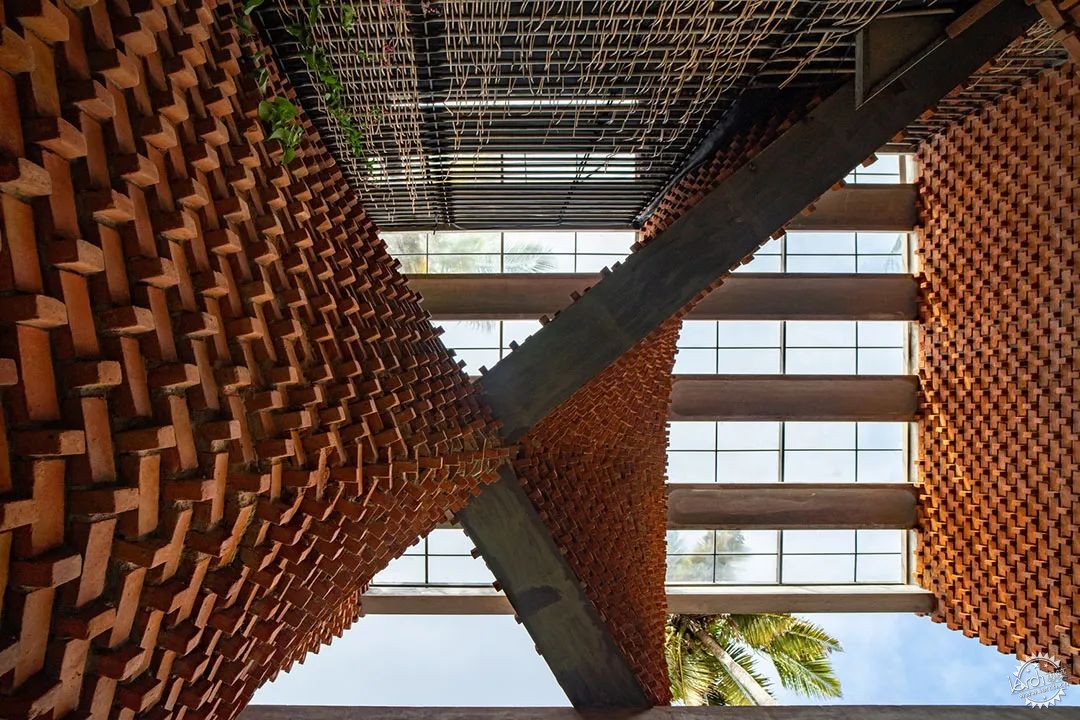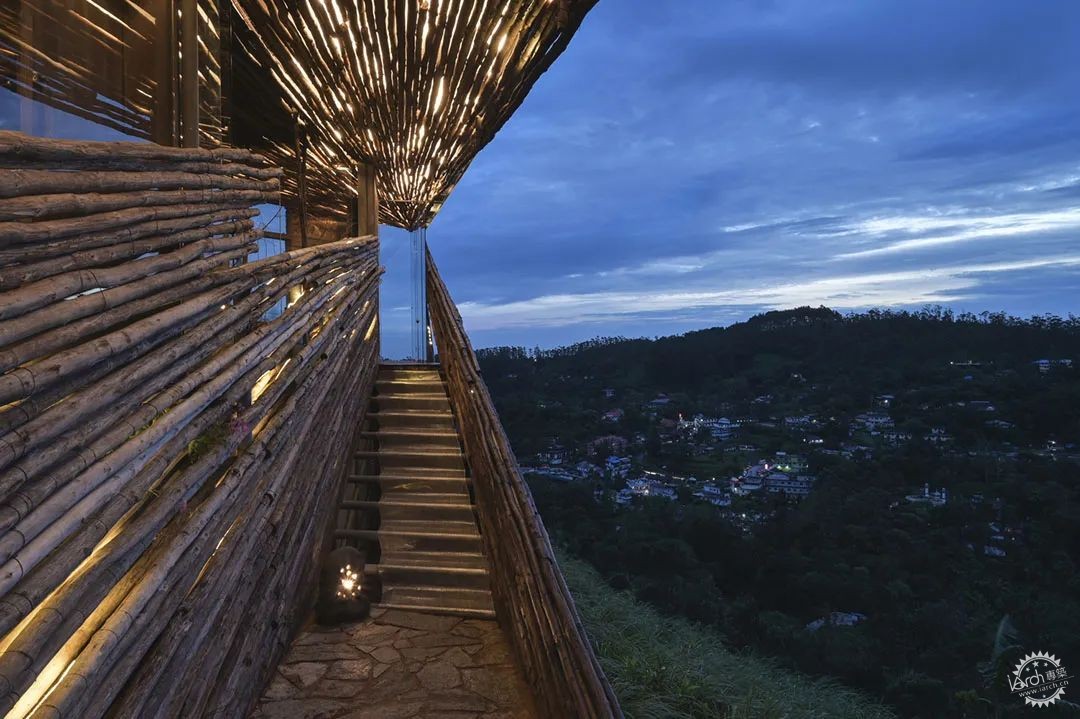
Image © Jino Sam
“我感觉到建筑是一种罪恶”:采访Wallmakers事务所的Vinu Daniel
“I Am Always Mindful That Construction is a Sin”: Interview with Vinu Daniel of Wallmakers
由专筑网Zia,小R编译
大多数建筑师在舒适的办公室里设计项目,坐在办公桌前,在电脑上做着决定,似乎可以远程操控着施工现场。这种方式可能可以设计出前卫的或是客观上美观的建筑,但无法真正满足一些特定建造的要求。那么这些问题如何解决呢?是否有可能建造一些新的东西,就好像它是已经存在的事务的延伸,同事有着最内在、有影响、但却原始的形式?印度南部喀拉拉邦首府特里凡得琅的获奖建筑事务所Wallmakers的创始人Vinu Daniel说,找出答案的唯一方法就是从场地本身开始。
他说:“建筑实践不应该是把一堆文件从办公室转移到现场。”建筑师的工作应当直接来自于现场,来自于以最触手可及的方式。这一切都始于对场地的考察,并利用现场周围步行范围内的材料,如土壤、砖块和各种废弃物,甚至包括轮胎、啤酒瓶,甚至废弃的塑料玩具。这种方法可以产生高度原创的作品,比如独户住宅,它们都拥有独特的物理反应。
Most architects design projects in the comfort of their offices, sitting behind their desks, making decisions by looking at their flatscreens, never visiting a construction site, and managing everything remotely. This attitude may lead to a design of a sleek and even objectively beautiful building. But such a solution can’t be anywhere near a genuine response to what any given site may require. How do you even find out? Is it possible to build something new as if it were an extension of what is already there in the most innate, consequential, yet original form? The only way to find out is to start from the site itself, says Vinu Daniel, the founder of Wallmakers, an award-winning architectural practice in Trivandrum, the capital of the southern Indian state of Kerala.
He told me: “An architectural practice should not be about transferring a bunch of papers from the office to the site.” The architect’s work emerges right from the site, from his direct engagement with it in the most tactile ways. It all starts by examining the place and working with materials that are available within walking distance around the site – soil, brick, and all kinds of waste, including tires, beer bottles, and even discarded plastic toys. This disciplined approach has resulted in highly original work – mostly single-family residences – a unique physical response every time.

Image © Jino Sam
Vinu Daniel 1982年出生于迪拜,在阿布扎比的一个传统印度家庭中长大,有两个哥哥姐姐。他的父亲在阿联酋管理一家办公用品企业。后来Daniel回到他的祖国,在特里凡得琅工程学院的建筑学校学习,并在位于北部的奥罗维尔地球研究所学习了两年。在那里他了解了用土壤、水泥和砖块建造工程的过程。他在2007年开始了他的实践,向他的工匠们传授随着时间流逝而消失的传统建筑技术,这些技术结合了现代和传统的做法,是他在奥罗维尔学到的。目前,他雇用了超过100位工匠,在印度各地从事近20个项目的设计和施工,每个项目都由一名建筑师直接驻扎在现场指导。
在对Vinu Daniel进行采访时,他正在纽约班加罗尔郊区监督目前正在建设的一个项目——一所农场学校。我们谈到了他对废物建筑的关注,以及在喀拉拉邦执业的英国建筑师Laurie Baker对他的影响,他们都习惯于亲力亲为,并且在建设过程中充分考虑生态环境。
Vinu Daniel was born in Dubai in 1982 and grew up in Abu Dhabi in a traditional Indian family with two older siblings. His father managed an office supplies business in the UAE. Daniel returned to his ancestral homeland to study at architecture school at the College of Engineering in Trivandrum, after which he spent two years at the Auroville Earth Institute, just north of Pondicherry, where he learned about the engineering processes behind building with soil, cement, and mud blocks. He started his practice in 2007 by teaching his craftsmen traditional building techniques that were lost over time and which he learned in Auroville. His techniques incorporate both modern and traditional practices. Today he employs between 100 and 150 people, mostly craftsmen. He currently works on the design and construction of nearly 20 projects across India, each led by one of his architects stationed directly at each of these sites.
In our interview with Vinu Daniel over Zoom between New York and the outskirts of Bangalore, where he was overseeing one of his projects currently under construction, a farm school, we talked about his mission-like focus on building with waste, the influence of British architect Laurie Baker who practiced in Kerala, working with his own hands, and how to preserve ecology instead of building over it.

Image © Syam Sreesylam
Vladimir Belogolovsky:你的所有项目都非常有意识地处理废物问题。这意味着,你的项目都代表了你关于废物问题的态度,对吗?
Vinu Daniel:当然了。现在不是应当有人对此有坚定的立场吗?前几代的建筑师们生活在不同的时代,但现在我们的资源非常有限,我们必须注意建筑材料来自哪里,成本如何,这就需要我们在这方面有想法。我不是指责任何人,只是认为我们可以为此做到一些事情。我认为这是一个机会,利用废物进行建筑工作并没有受到足够的重视,但我认为这是一个充满神奇机会的领域。
Vladimir Belogolovsky: All your projects deal with waste very consciously. This means that every one of your projects is a statement about waste issues, right?
Vinu Daniel: Of course. Isn’t it time for someone to have a strong position about this? Previous generations of architects lived in a different kind of time. Now we have very limited resources and we must be mindful of where building materials come from and at what cost. We need to be intelligent about that. And instead of blaming anyone, we can do something beautiful about it. I see it as an opportunity. Building with waste was never considered a challenge. I see it as a whole new world of fantastic opportunities.

Image © Jino Sam
VB:为了描述你的作品,你使用了诸如简单、合理和美观等词汇。你还会用什么词来描述你试图实现的那种建筑?
VD:我一直在想的一个词是未来。如果商业建筑师继续按照他们今天的方式运作,未来将是黑暗的。建筑师们怎么能确定他们在舒适的办公室里规划的东西都会以某种方式来实现?而且,这不仅仅是单个项目的问题。项目需要相互关联,并考虑到我们的整体环境。建筑师必须走出办公室,去往现场,为一个更好的未来而努力。
VB: To describe your work, you use such words as simplicity, rationality, and beauty. What other words or short phrases would you use to describe the kind of architecture that you try to achieve?
VD: One word that I always think about is the future. If commercial architects continue to operate the way they do today, the future will be dark. How can architects be sure that whatever they plan in the comfort of their offices somehow would turn out to be okay? And it is not just about individual projects. Projects need to be interrelated and mindful of our environment overall. Architects must get out of their screen spaces more often. We all must work toward a better future.

Image © Syam Sreesylam
VB:你的客户都有哪些?
VD:他们都是非常不同的人,从牧师到电影制片人,再到政治家。我们现在正在一个已故传奇音乐家S.P. Balasubrahmanyam建造的农场里建造一个博物馆。而我最初的客户都是熟人。
VB:你在谈到你的工作时说,“我们制作的结构既有功利性又有诱惑力”。所以,你非常注意作品的外观,对吗?它必须是美观的。
VD:当然了! 为什么像特斯拉这样的产品会如此受欢迎?不仅是因为其中所传达的可持续发展的信息,更多的是它们的形象。可持续发展并不是要回到过去,按照我们祖先的方式做事。可持续发展意味着展望未来,展望更进步、更可持续的各种新技术和工艺。
VB: Who are your clients?
VD: Very different people – from pastors to filmmakers, to politicians and we are now working on a museum on a farm built by a legendary late musician, S.P. Balasubrahmanyam. My initial clients were all relatives.
VB: You said about your work, “We make structures that are both utilitarian and alluring.” So, you are very mindful of how your work looks, right? It must be beautiful.
VD: Of course! Why are products such as Tesla so popular? Not only because of their message of sustainability but more so because of their image. Being sustainable is not about going back in time and doing things the way our ancestors have done. Being sustainable means looking forward to the future, looking forward to new kinds of technologies and techniques that are more progressive and sustainable.

Image © Anand Jaju
VB:你能谈谈Laurie Baker对你工作的影响吗?
VD:正是因为看到了他的作品,才确定了我今天作为一个建筑师的身份。我很幸运能见到他,他邀请我们这些学生去他家,在大约四个小时的时间里,我对他的世界有了了解,这改变了我对建筑的态度。在那之后,我开始注意到废物利用,并思考其作为建筑材料的潜力。Baker促进了区域性建筑实践的复兴,依靠当地的材料,强调了对资源和能源的负责和谨慎使用。他是以最有机的方式进行可持续建筑的先驱者。那次会面非常深刻地影响了我的信念,在那之前,我对是否要在专业上追求建筑有疑问,而与他的会面明确了我的选择。
VB: Could you talk about the influence of Laurie Baker on your work?
VD: It was discovering his work that defined who I am today as an architect. I was lucky to meet him when he invited us, the students, to his home and I got an incredible insight into his world for around four hours, which changed my attitude towards architecture. After that, I started noticing a lot of waste and thinking about its potential as a building material. Baker promoted the revival of regional building practices, relying on local materials, and he emphasized the responsible and prudent use of resources and energy. He was our pioneer of sustainable architecture in the most organic ways. That meeting influenced my beliefs very profoundly. Before that, I had doubts about whether to pursue architecture professionally. Meeting him solidified my choice.

Image © Anand Jaju
我从他那里学到了五英里半径的材料采购原则,我对建筑的许多想法都是我对他的建筑实践思考的结果。可以说,他是我们的引路灯。他使喀拉拉邦摆脱了传统的思维方式,给了我一个方向。如果我在印度的其他地方,可能都不会有如此直接的影响。但在我遇到他的时候,他并没有被誉为一个突破性的建筑师。他会受到批评,有人说他的建筑不会持久,不适合居住,对自然太开放,没有足够的围合等等。但他为我和其他许多年轻的建筑师铺平了道路,让我们开始实践探索一些开创性想法。尽管有各种批评,他还是无畏地追求他的理想。
I learned about the five-mile radius material sourcing from him and many of my ideas about architecture are the result of the reflections I had on his practice of architecture. He was our Hercules, so to speak. He moved Kerala out of the traditional mindset. He gave me a direction. If I were in any other state in India, this would not have such a direct impact. But at the time I met him he was not celebrated as a breakthrough architect. He was criticized a lot. It was said about his buildings that they would not last, they were not fit for habitation, they were too open to nature, did not have enough insulation, and so on. But he paved the way for me and many other younger architects to start our practices to explore his pioneering ideas. He was fearless in pursuing his projects despite all the criticism.

Image © Jino Sam
VB:谈到你的工作,你说:“很多时候,我在现场手动处理泥浆,我用我的双手工作,我认为这有很大的乐趣,因为开始在一个全新的水平上理解材料。”所以,你是一个自己建造建筑的建筑师,是吗?
VD:我相信,只有当你开始用自己的双手工作时,你才能理解你作为一个建筑师在做什么。很多建筑师尽管没有任何经验,也可以轻松地在一张纸上设计出机场。但如果给他几块砖,他们就不知道该怎么做了。建筑师是纸和笔的主人,但他们对砖没有同样的感觉,他们会觉得被吓到了。但我对砖有熟悉的感觉。就像其他人对笔和纸的感觉一样。所有的建筑师都有一本素描本,他们可以在上面天马行空。但我希望建筑师们对他们打算使用的材料感到同样的熟悉。他们越是与之打交道,就越是感到自在,找到每种材料的真实性质并与之相适应是很重要的。在这方面,我一直在向我的工人学习。
VB: Speaking about your work you said, “Very often, I manually handle the mud on site, I work with my hands — I think there is great pleasure in that, and one begins to understand material on a whole new level.” So, you are an architect who builds your own buildings, right?
VD: I am convinced that you can only understand what you are doing as an architect when you start working with your own hands. So many architects without any hesitation, despite not having any previous experience, will design a whole airport on a piece of paper. But if the same person is given a few bricks, they wouldn’t know what to do with them. Architects are masters of pen and paper, but they don’t feel the same with bricks. They feel intimidated. But I feel at home with the brick. Just like others feel at home with pen and paper. All architects have a sketchbook. They can go to any extreme in their drawings. I want the architects to feel as comfortable with the material they intend to work with. The more they work with it the more they will feel at ease. It is important to find the true nature of each material and to be in tune with it. I learn from my workers all the time.

Image © Jino Sam
VB:关于Mananthala的IHA住宅,你在沼泽地上建造的房子,你说:“比起房子本身,我对我没有建造的东西或者说我能够保留的东西更加自豪。而每一个新的项目,我都会再次成为土地的学生,场地会决定这个过程。”
VD:(笑)那所房子对我来说是一个转折点。那时我觉得我是用砖头建造的大师,而我也想掌握景观工作。我发现,很多景观都是完全人造的,比如有很多进口植物,可能看起来很美,但它们在这个地方没有归属感。慢慢地,我开始明白,现实中的沼泽地、坑洞和其他生态环境比我们在电脑上制作的任何东西都更真实,这些完全可以取代它们。所以,我的想法不是安插新的植物,而是利用那里已经存在的植物。它们已经足够美丽了,更重要的是,现有的生态环境能够被改善吗?
VB: About your IHA Residence in Mananthala, the house you built over a swamp, you said, “I'm more proud of what I didn't build or rather what I was able to preserve than of the house itself. And with every new project, I become a student of the land again, and the site will define the process.”
VD: [Laughs.] That house was a big turning point for me. By then I felt I was the master of building with brick. And I wanted to also master working with landscape. What I discovered is that so many landscapes are entirely artificial. There are so many imported plants there. They may look beautiful, but they don’t feel belonging in the place. And slowly I started to understand that the swamps, pits, and other ecologies that we so often build over are more real and important than whatever we make on the computer to replace them. So, the idea was not to bring new plants but to have the same plants that already exist there. They are beautiful enough. More importantly, the question is — Can the existing ecology be improved?

Image © Anand Jaju
那所房子的场地有一片沼泽,里面有两条蛇。因此,我们为它们建造了一个特殊的围栏,并将房子抬高在上面,这样蛇就不容易进入房子,房子里的居民也不会无意中接触到它们。这样一来,蛇就可以继续过自己的生活。毕竟,谁才是那里真正的原住民?毫无疑问,植物和动物先来到那里。承认它们的所有权也是很重要的,因为这些蛇是出色的守护者,它们保卫房子不受老鼠的侵扰。这也是一个面对生态环境的解决思路,这些蛇必须被保存下来,它们通过捕食青蛙、蠕虫、蟋蟀、蜘蛛、蚊子和啮齿动物来生存,而且它们对人是无害的。
The house you mentioned had a swamp and two snakes in it. So, we built a special enclosure for them and elevated the house over it in such a way that the snakes could not get into the house easily and no inhabitants of the house would come in contact with them unintentionally. This way the snakes can continue to live their own lives. After all, who are the real inhabitants there? The plants and animals were there first. It is important to recognize their ownership as well. And these snakes are wonderful guardians. They defend the house against infestation of rats, which is often a problem. These snakes must be preserved for our ecology to survive and they feed on their own by preying on frogs, worms, crickets, spiders, mosquitos, and rodents, of course. And they are harmless to people.

Image © Anand Jaju
VB:你说,“我是一个缓慢的建设者,我不着急”。能详细解释一下吗?
VD:(笑)完全正确!我正在一砖一瓦地建设。嗯,一砖一瓦地建造。这需要时间,我试图小心谨慎,考虑到我可能会因为建造东西而伤害到什么。我也很谨慎,因为我总是感觉建筑是一种罪恶,你需要尽可能地减少伤亡和影响。所以,要小心,要慢。
VB: You said, “I am a slow builder. I take my time.” Could you elaborate?
VD: [Laughs.] This is absolutely true! Well, I am building brick by brick. It takes time, you know? I am trying to be careful and considerate about what I may be harming by building something. I am being cautious because I am always mindful that construction is a sin. You need to limit the casualties as much as possible. So, be careful and be slow.

Image © Jino Sam
VB:而你说,“建筑不再是一种职业,事实上,它已经成为一种危害”。
VD:因为如果我们继续以今天的方式进行建设,我们将摧毁一切。我们有这么多的生态灾难,很多都是通过非常不负责任的建设方式造成的。这样做,我们在人与人之间制造了很多的隔阂,我们不再能像以前那样相互接触,建筑师创造了太多的界限。
VB: And you said, “Architecture is no longer a profession, but it has, in fact, become a hazard.”
VD: Because if we continue building the way we are building today; we will destroy everything. We have so many ecological disasters, but it is we who created these problems in the first place by building very irresponsibly. And doing so we have created so many boundaries between people. We no longer can engage with one another the way we used to. Architects created too many boundaries.

Image © Jino Sam
VB:我想用你的另一句话来结束采访,“每一个新的项目都是不同的,每一次你都会有新的设计顿悟”。
VD:(笑)确实如此!
VB: I would like to end with another one of your quotes, “Every new project is different, and every time you pray for a new design epiphany.”
VD: [Laughs.] I really do!

Image © Jino Sam

Image © Jino Sam

© Jino Sam

Image © Syam Sreesylam

Image © Syam Sreesylam

Image © Syam Sreesylam

Image © Syam Sreesylam

Image © Anand Jaju

Image © Anand Jaju

Image © Anand Jaju

Image © Jino Sam

Image © Anand Jaju

Image © Jino Sam

Image © Jino Sam

Image © Anand Jaju

Image © Anand Jaju
|
|
